For many of us, each morning starts with a cup of liquid bliss. Black or with milk, sweetened or bitter, coffee has become more than just a plain hot drink. We meet our friends, discuss business or simply unwind over a coffee. And in the past year or so, more and more of us have dedicated more time to prepare our cup of coffee at home.
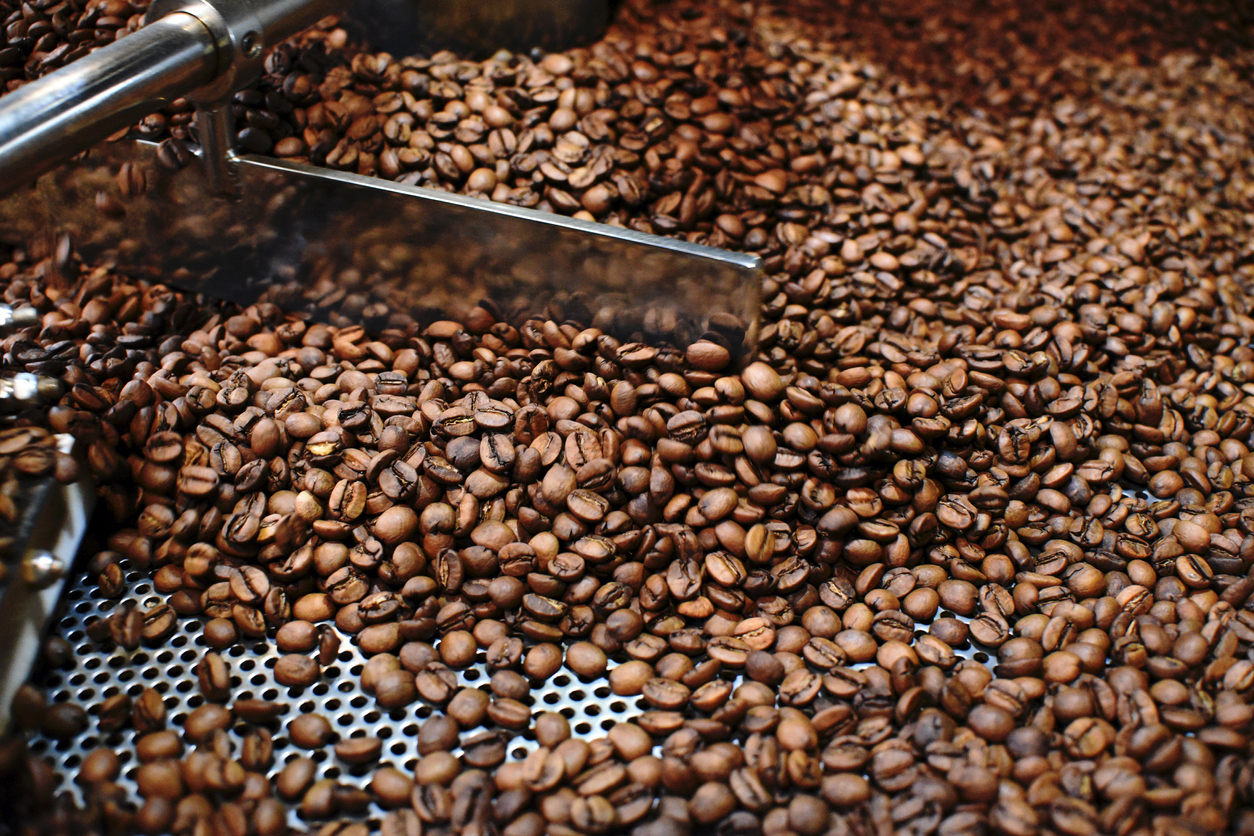
Making the ultimate cup of coffee in the comfort of your own kitchen may sound simple. But if you are as meticulous as we are, then you know there is more to it than meets the eye. From top-quality materials to the process of roasting, grinding, brewing, there is a lot to know and do. Not to mention, your barista skills must be on point when you try to decorate. Of course, if you are not much into crafting your own energy potion, coffee shops can always count on you as a client.
This article though, is for the curious minds. For those of you out there who already know their coffee down to the last drop. Those who strive to get to know the magic that turns brown beans into black, flavorsome bliss. There is so much to say when we are talking about coffee beans. If you truly want to control the intensity, flavor or taste of your coffee, roasting is essential. Today’s article tells you all you need to know about roasting coffee beans at home. We prepared it all, from stages, tips, down to an exquisite selection of the best home coffee roasters.
Are you ready to start roasting coffee beans like a professional? Keep reading to learn more about it!
Our Top Home Coffee Roaster Machines
In a rush, here’s our list of the best home coffee roasters.
| Product | Capacity | Best Features | |
| 1. | Fresh Roast SR540 | 120 grams | Compact and easy to use, even for a beginner |
| 2. | DYVEE Gas Burner Coffee Roasting Machine | 400 grams | High visibility during roasting -quartz glass drum |
| 3. | ANGELLOONG Air Coffee Roaster | 80 grams | Customizable roasting settings, cooling feature |
| 4. | KALDI Home Coffee Roaster | 200 grams | High-end product, fully accessorized |
| 5. | Nuvo Eco Ceramic Handy Coffee Bean Roaster | 70 grams | Portable, a no-brainer to use, unique design |
| 6. | JIAWANSHUN Electric Coffee Bean Roaster | 450 grams | Compact, powerful, high capacity, suitable for popcorn too |
| 7. | Stainless Steel Drum Coffee Bean Roaster | 600 grams | Large capacity, compatible with various heat sources |
| 8. | KALDI Mini Size Home Coffee Roaster | 250 grams | Sturdy construction, high quality materials |
Why Roast Coffee At Home?
Of course, you can buy your coffee already roasted. But deep down, you know you will be way more satisfied if you roast it yourself (to perfection). Here’s why you should consider roasting coffee beans at home:
-
Creativity
If you want to take full control over what goes inside your cup, roasting is probably on your list already. Observing, experimenting, refining the way beans get roasted are part of the process.
-
Enjoying fresh coffee
Unlike packaged coffee (beans included), making your own roast means you enjoy it fresh. The intense flavor, the taste, it is all better when your roast is only a few days old, rather than weeks or months.
-
Saving money
At first, you may need to invest in some quality equipment to get your roast as close to perfection. But in the long run, buying green coffee beans and preparing them for brewing at home will help you save up.
-
Homemade delights
Impress your friends with homemade gifts or even consider opening a small business. Roasting coffee beans at home gives you the freedom to do both, depending, of course, on how much you plan to prepare.
Downsides Of Roasting Coffee Beans At Home
You may already see yourself spending your Sunday mornings roasting at home. But before making a decision, you should definitely weigh the downsides. When it comes to investing in a coffee roaster machine, here is what is important to keep in mind.
-
Time
If you prefer to get you coffee on the go most of the time, then a home coffee roaster is not your thing. But if you like to leave your print on what you drink, sounds like you should consider getting such a machine. You need to devote some time to roast and cool off your beans every week, if you wish to enjoy the rich flavor at its best.
-
Effort
While modern machines do simplify the process of roasting, you still have to put in some work. You have to try and fail a few times until you get the right temperature, or roasting time. All the effort is worth it in the end though, when you obtain the flavor you enjoy most.
-
Investment
While buying green beans may be cheaper, if you aim to roast like a professional, you have to invest. Unlike a pan, getting a coffee bean roaster can drain a few hundred dollars from your budget.
Features to Look For in a Coffee Bean Roaster
Let’s now take a step back. There is so much to know about roasting coffee beans at home, that you may feel overwhelmed. And it would be no surprise if you are less inclined to want to try it yourself. The good news is that with the help of modern appliances, even the most intricate tasks become a breeze. There is a wide variety of home coffee roasters available. And we want to make the task of choosing one easier for you. So, here are the key features to look for in a coffee roaster machine.
-
Capacity
Roasting coffee for your own personal use or for a large family are two different stories. Consider how much coffee you need to roast and pick a home coffee roaster suitable for that.
-
Size
The overall size of a home coffee roaster machine matters. Especially when the free space on your kitchen counter is rather limited.
-
Cooling Features
You can cool off the roasted beans using two colanders. But things are far better when your coffee roaster machine can handle this part too.
-
Smoke Control
If you are a fan of dark roasts, prepare yourself for a considerable amount of smoke. Finding a coffee bean roaster that handles/reduces smoke can come in handy. You want to avoid turning on your fire detectors while roasting.
-
Fine Tuning Options
The more control, the better, especially when it comes to creating the perfect roast. A coffee roasting machine on which you can save your favorite settings is a good investment.
Our Selection Of 8 Best Home Coffee Roaster Machines
Be honest, you probably had at least one cup of coffee while reading so far. And we get you, nothing can compare with the rich flavour of a fresh brew flooding your senses. So, let’s get down to business. Make the first step to roasting coffee like a professional.
Pick your favorite home coffee roaster from our exquisite selection below. We have eight top-notch coffee bean roasters, thoroughly analyzed.
1. Fresh Roast SR540 Home Coffee Roaster
The Fresh Roast SR540 is perfect for anyone starting their journey of home roasting. Easy to use and compact, this coffee bean roaster can fit in any kitchen. With a real-time temperature display and 9 levels of heat, it allows you to experiment at ease.
The fan settings make it easier to adjust the airflow intensity also. As the improved version of the old SR500, this machine does a fine job and also has a warranty, so you roast worry-free.
Pros:
- compact design
- small countertop print
- real time temperature display
- 9 levels of heat
- several fan settings
- easy to use (knob-turn adjustments)
- one year warranty.
Cons:
- limited roasting capacity (only 120 grams)
- not suitable for dark roasts
- low efficiency of the chaff collecting feature
- plastic components prone to breaking (several complaints).
2. DYVEE Gas Burner Coffee Roasting Machine
Delight your eyes with the DYVEE Gas Burner Coffee Roasting Machine. And we mean not only with its outstanding design, but also with the view of your beans roasting.
The quartz glass drum allows you to keep a close eye on the process, seeing how the green coffee turns shiny brown. The sturdy steel frame and wooden handle keep you safe while the drum can accommodate up to 400 grams of coffee.
Pros:
- easy to use on any kitchen stove or gas burner
- large capacity (400g)
- unique design
- high visibility during the roasting process.
Cons:
- noisy (several reviews claim difficulty in hearing the second crack)
- heavy body
- long time required for roasting (up to an hour)
- lack of cooling or chaff collecting features.
3. ANGELLOONG Air Coffee Roaster
Cooling off your coffee beans has never been easier. The ANGELLOONG Air Coffee Roaster does it for you with a button press. This electric coffee roaster provides efficient hot air circulation. So your coffee beans roast evenly and efficiently. And there is less smoke in the process too.
The cooling feature comes in handy to keep your roast flavorsome, just as you like it. And the timer gives you the freedom to experiment, while staying in control of the roast.
Pros:
- intuitive, easy to use design
- cooling function
- built-in timer
- hot air circulation system (less smoke, better chaff separation)
- high visibility (transparent roasting compartment).
Cons:
- small capacity (80g)
- plastic components prone to breaking
- noisy operation.
4. KALDI Home Coffee Roaster
If you are ready to stop playing around, the KALDI Home Coffee Roaster is for you. Take the reins over every detail in roasting coffee at home.
A top-of-the-line product, this home coffee roaster comes equipped with plenty of accessories. So you have it all set for creating your perfect blend. The sturdy stainless steel body has a unique design for improved air circulation.
Pros:
- sturdy construction (stainless steel structure)
- various accessories included (thermometer, hopper, probe rod, chaff holder)
- effective air circulation design.
Cons:
- metal housing prone to heating up (burn risk)
- chaff collecting less efficient
- not compatible with all burner grates
- high-end product.
5. Nuvo Eco Ceramic Handy Coffee Bean Roaster
Mix it up a little bit. Literally. The Nuvo Eco Ceramic Handy Coffee Bean Roaster gets you really involved in roasting. Shake your coffee beans and listen to their flavorsome popping.
The waffle-shaped design of this home coffee roaster ensures even heat distribution. You may not use it to roast for the whole family, but when you go camping, you will definitely love how practical this is.
Pros:
- portable, easy to use
- even heat distribution (waffle-shaped design)
- suitable for camping
- cowhide grip
- durable ceramic structure
- affordable.
Cons:
- not compatible for induction stovetops
- limited capacity
- no thermometer/timer/ cooling features
- handle prone to heating (glove use recommended).
6. JIAWANSHUN Electric Coffee Bean Roaster
Save your budget from excessive investments. You can get a great job done with the JIAWANSHUN Electric Coffee Bean Roaster.
Powerful, adjustable, with a generous capacity, this roasting machine takes little space too. You can prepare your coffee batch for the week, then store it away with ease. Cleaning is hassle-free too.
Pros:
- heat-proof glass cover
- non-stick layer (easy to clean)
- stirring element for increased airflow and even roasting
- affordable
- large capacity
- automatic heating
- wide temperature range (100– 240°C).
Cons:
- longer operation for darker roasts
- no chaff collecting feature
- non-stick layer prone to wearing off in time.
7. Stainless Steel Drum Coffee Bean Roaster
This Stainless Steel Drum Coffee Bean Roaster takes roasting to a new dimension. It comes with an electric motor to reduce the effort you have to put in.
The sturdy structure can resist high temperatures for a long time. Smoke exhaust is a breeze, thanks to the cooling holes placed at each end of the drum. Do make sure you use it in a well-ventilated space, especially for dark roasts.
Pros:
- versatile (suitable for coffee beans, grains, peanuts etc)
- durable materials (stainless steel frame)
- large capacity
- airflow-friendly design
- metallic mesh suitable for faster cooling
- silent motor
- compatible with various heat sources
- affordable.
Cons:
- no temperature control
- constant observation necessary
- consistent smoke release
- no chaff collector.
8. KALDI Mini Size Home Coffee Roaster
The KALDI Mini Size Home Coffee Roaster keeps things simple and pushes you out of the comfort zone. Suitable for small amounts of coffee beans, it will take little space on your counter. This roaster machine crosses off the list the fancy modern features. You get to play and get hands on with the timing, setting the temperature and so on.
Pros:
- accessories included (thermometer, sampler, hopper)
- compact, sturdy structure
- even roasting (rotating drum design)
- constant airflow.
Cons:
- no cooling feature
- considerable smoke release (not suitable for indoor use)
- no chaff collector
- unclear instructions
- expensive.
Coffee Bean Roaster at Home: FAQ
If you have read this far, then it means you are truly determined to know more about roasting at home. So, below you can find a quick overview of the main aspects related to this process.
What Do You Need To Roast Coffee Beans At Home?
Depending on how eager you are to get a taste of homemade roast, you can use utensils you already have in the house. Or you can invest in a professional home coffee roaster.
You will need to buy green coffee beans. You can check your local coffee shops or any roasters in your region for supplies. Try to learn as much as possible about your coffee beans. Knowing about the quality, origin, moisture level can help you create a balanced blend. Do not be shy to ask for advice from your regular coffee shop too.
If you are on a tight budget, you can try to roast a small amount of beans in a skillet or in the oven. It can be rather tricky to get the process right from the first attempt. Roasting depends a lot on the heat level and an even distribution. Air circulation plays an essential role in that. When roasting in the oven, it is harder to keep stirring the beans. In a skillet, you need enough space to keep the beans moving. To know more about how to roast coffee beans in a skillet or pan, check out this article. If you want to give roasting in the oven a try, here is a thorough guide to help you out.
If you want to up your roasting game, then you can go gradually or straight to the pro solution. In other words, you can use a hot-air popcorn machine to roast small amounts of green coffee beans. Here you can find out more on how to use them. Or you can save up and invest in a quality home coffee roaster machine. These are, by design, created to help you obtain an even, rich roast.
Once your beans are well roasted, it is crucial to cool them off fast. We recommend you have two metal colanders (and oven mitts) ready. Transferring your roasted beans from one colander to another will cool them faster. And also helps remove some of the chaff resulting from roasting.
Finally, airtight containers should not be missing from your home. You should keep your fresh roast sealed, to preserve the flavor for as long as possible.
RELATED READING: Best Drip Coffee And Single Coffee Makers by Coffee Pros
From Light To Dark — What Is Your Kind Of Roast?
Green coffee beans have around 300 natural compounds (caffeine included). A lot changes while roasting, as heat leads to various chemical reactions. So roasted beans end up containing about 1,000 compounds. From minerals to antioxidants, fiber or carbohydrates, coffee beans have them all. And the process of roasting is far from plain and simple.
Depending on how much you roast coffee beans, properties change. The flavors brought to life, the color and the dehydration level vary. And our taste for coffee differs as well. You may enjoy a light roast, while your friends prefer a dark roast. And in between the two, there is a world of variations. To help you navigate your way through all the names, below is a quick insight into the universe of coffee roasts.
There are four most common denominations that illustrate the different levels of roast. These include Light, Medium, Medium-Dark, and Dark Roast. As standardization is not practiced in the coffee industry, these names may vary. So running into coffee roast variations like Full City or French Roast may be rather common.
Now, what do these names refer to? Level of caffeine or color? Well, various types of roasts are usually differentiated based on their internal temperature. Specifically how hot they actually are when you take them out of the roaster.
- LIGHT ROAST
The first level of roasting causes beans to develop a light brown color, keeping a dry surface and a higher level of acidity. Their internal temperature should stay in the range between 356-401°F. Coffee made with light roasted beans is milder. You may also encounter these roasts under names like Cinnamon Roast, Light City, Half City.
- MEDIUM ROAST
One of the most popular types, the medium roast comes with a mid-level acidity and stronger flavor. Other names you can find it under include City Roast, American Roast or Breakfast Roast. The temperature necessary to obtain this roast goes between 410-428°F. To know when your beans reach this stage, look out for the first crack. Beans stay dry, non-oily on the surface, but get a darker brown color.
- MEDIUM-DARK ROAST
Oil starts to find its way to the surface, while the internal temperature is 437°F- 446°F. Beans approach the second crack and grow in size. A rich flavor, with a dash of sweet bitterness pairs up with a darker color and lower acidity. You can find this variety named as Full City, Full City Plus or Vienna Roast.
- DARK ROAST
Dark roasts may bring a considerable amount of smoke in your home. The beans get dark, shiny and develop a strong bitter flavor, but low in acidity. Keep heat below 482 °F, to avoid actually burning them. The roasting temperature starts at around 464°F. Most common names used for these roasts are: Espresso, French or Italian.
RELATED READNIG: How to Make Espresso Without An Espresso Machine
Key Aspects of a Coffee Roaster
The web offers a large variety of guides and instructions when it comes to home roasting. What we aim to provide you here is just a dash of inspiration and knowledge. So, here are some key concepts and terms you will often find mentioned in home coffee roasting texts.
- Internal temperature
The level of heat is essential to get the roast you like most. You will go through several trials and errors until you get the hang of it. That applies especially for when you use a skillet or a popcorn machine. Getting the recommended bean temperature (BT) right ensures your roast is well balanced.
- Airflow
Stirring the beans is crucial for an even roast. Having enough airflow and proper contact with the heat gives you the full body roast you want. This also makes it easier to reach that ideal heat level and smooth temperature drop.
- First Crack
At the beginning, green coffee beans only dehydrate under the heat. But once the sugars caramelize, the beans expand. The first crack refers to a loud sound they make, similar to popping popcorn. It is the signal that the beans reached the primary level of roasting (light roast).
- Second Crack
The hotter the beans get, oils start reaching their surface, making it shiny and darker in color. Caramelization continues and the flavor intensifies. As the body expands, a second, louder crack marks the dark roast level. Soon after this point, you need to remove beans from the heat or they will burn too much.
- Cool Off
The coffee beans will keep transforming as long as they are hot. So even if you remove them from the fire/heat, to maintain the roast as you like it, cooling proves very important. Your roasting machine could have a special cooling feature. Or you can do it yourself with colanders. Focus on making your coffee beans temperature drop fast.
- Chaff Removal
During roasting, the external shell of coffee beans comes off as chaff. It has a dusty texture and is usually easy to remove during the cool off stage. With plenty of airflow, the chaff will separate easily.
- De-gas
During roasting, various gases form inside your coffee beans. As a result of the chemical reactions, consistent amounts of carbon dioxide form. This is not actually bad, according to the Journal of Agricultural and Food Chemistry. A report from 2018 illustrates the role carbon monoxide plays in the coffee body, flavor, even shelf life. If CO2 evaporates too fast from your roasted beans, your coffee will turn stale, bland quickly. For the best results, allow your them to breathe out for 24h, and then pack them. Once most of the carbon dioxide gets released, your coffee beans are good to store. Experts recommend to still allow for 1-2 days before brewing. Ideally, you should consume freshly roasted coffee in about a week, to enjoy its best properties.
- Storage
Roasted coffee beans maintain their fresh, rich flavor best for up to a week. To help preserve it, you need to store them in airtight containers, far from heat sources or sunlight.
Home Bean Roasters: CONCLUSION
It is time to wake up and smell the coffee. Or better said, to pick your own coffee bean roaster and get hands-on in producing your favorite blend. We hope today’s guide inspires you to take more control over what goes in your mug.
Let us know in the comments how far you got on the road to making the perfect home roast. A great topic to talk more about it over a cup of fresh coffee, right?
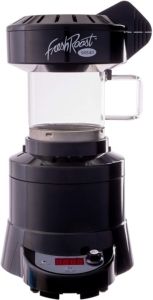
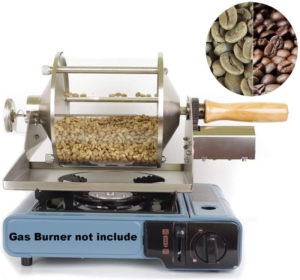
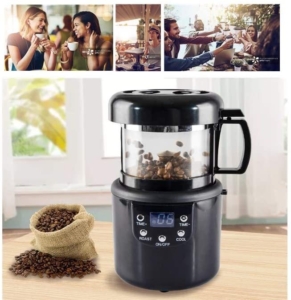
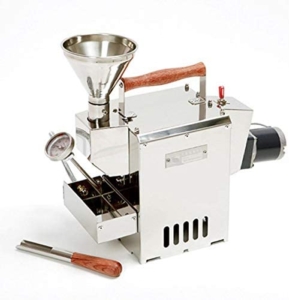
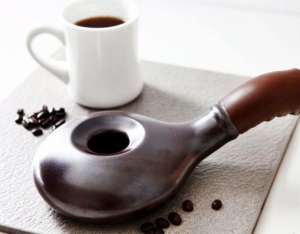
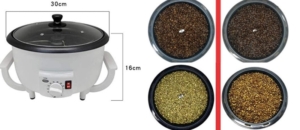
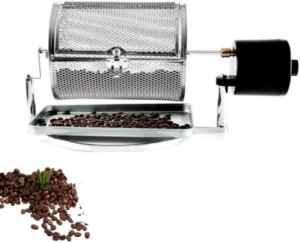
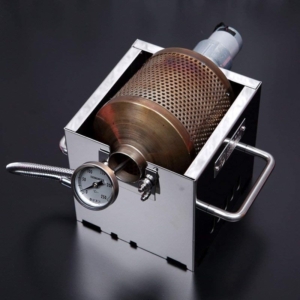
Leave a Reply